Gigabyte's i-RAM: Affordable Solid State Storage
by Anand Lal Shimpi on July 25, 2005 3:50 PM EST- Posted in
- Storage
Using the i-RAM
To begin our testing, we loaded up the i-RAM with four 1GB DDR400 sticks. We didn't have any large DDR200 modules, so unfortunately we had to go with more modern DDR400. Using DDR500, DDR400 or DDR200 doesn't change performance at all, since the Xilinx controller runs them all at the same frequency.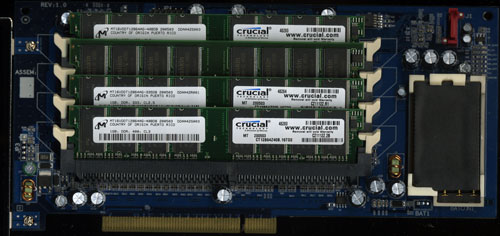
Powering the system on revealed the installation was a success; the BIOS reported the presence of the i-RAM as a regular storage device connected to our SATA controller:

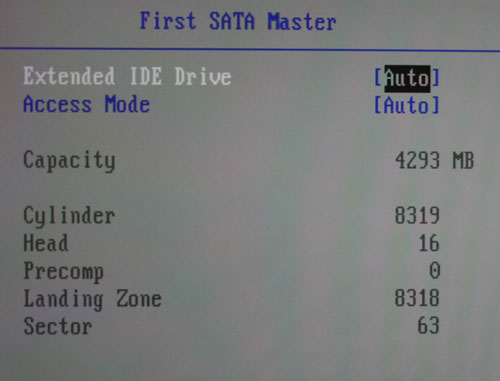
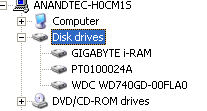
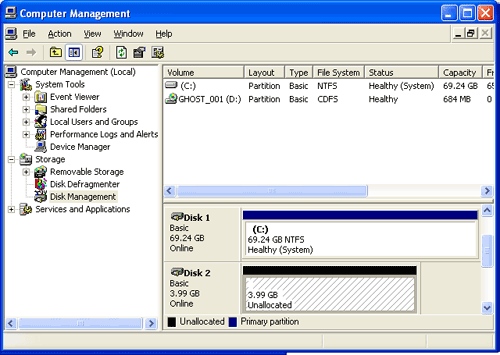
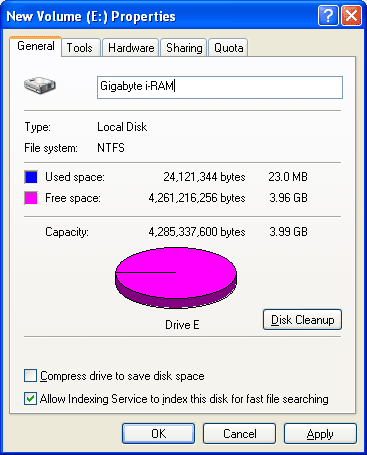
Also, all disk accesses are instantaneous; formatting the thing takes no time at all, and you can even "defragment" it (although, you get no benefit from doing so).
With the setup done, it was time to evaluate the i-RAM as more than just a novelty silent hard drive. Armed with our 4GB partition, we started testing...
The Test
We ran all of our tests on the following testbed unless otherwise noted:ASUS A8N SLI Deluxe nForce4 SLI Motherboard
AMD Athlon 64 FX-57 Processor
1 GB OCZ 2:2:2:7 DDR400 RAM
Seagate 7200.7 120 GB Hard Drive (boot drive)
Western Digital Raptor W740GD (test drive)
Gigabyte i-RAM w/ 4x1GB DDR400 modules (test drive)
We used the latest nForce 6.53 and ForceWare 77.72 drivers for our test bed, and paired it with the recently released GeForce 7800 GTX.










133 Comments
View All Comments
Aganack1 - Monday, July 25, 2005 - link
i thought they said that they were only going to make 1000. enought for the crazies who have money to burn...P.S. if any of you crazies are reading this i could burn some of that money for you... just let me know.
Houdani - Monday, July 25, 2005 - link
Thanks for running through the multiple roles for which the iRam might be useful. I'm rather surprised it wasn't MORE useful in the benches. I'd be interested in learning (i.e. slacking back and reading the results of someone else's research) why the i-Ram is still as large a bottleneck as it is. Yes it's faster than the HD, but why isn't it much, much faster? Are we seeing OS inefficiency or something else altogether?In the end, though, it doesn't fit my needs particularly well, so I'll pass this round. Maybe a future version will be more appealing in terms of cost, speed, size.
Sunbird - Monday, July 25, 2005 - link
maybe the SATA interface isn't fast enough?pio!pio! - Monday, July 25, 2005 - link
I'm constantly shuffling 1--3 gb mpeg2 files around...this would be greatGed - Monday, July 25, 2005 - link
Would it be possible for an NVIDIA or ATI graphics card that used TurboCache or HyperMemory to make use of the i-RAM?That might be interesting.
Anton74 - Monday, July 25, 2005 - link
No, absolutely not. Even if it were, the SATA interface is *way* too slow to be of use for something like that.And even if that were not a factor, why spend that kind of money on the i-RAM where the same amount would buy a *much* superior video card with its own dedicated memory?
Anton
kleinwl - Monday, July 25, 2005 - link
I think that this would be very helpful as a page file for workstations. Older workstations may be maxed out with 4GB and windows 2000 (which the company does not want to move over to xp-64) and still need additional ram for CAD/CFD/etc. This would be an easy upgrade with a reasonable amount of performance increase.sandorski - Monday, July 25, 2005 - link
Was hoping it would offer more, especially as a Pagefile. Any plans to make a PCI-e version(IIRC PCI-e has a ton more bandwidth than SATA), that would likely make this a Must-have. As it stands now I'd only use it for the silence in a HT Setup.Gatak - Monday, July 25, 2005 - link
Using PCI/PCI-e for transfers would require OS drivers which wouldn't be available for all OSes.sprockkets - Tuesday, July 26, 2005 - link
Keep in mind that for many years the ide/sata controllers are NOT on the PCI bus of the southbridge, so PCI is not a limitation.